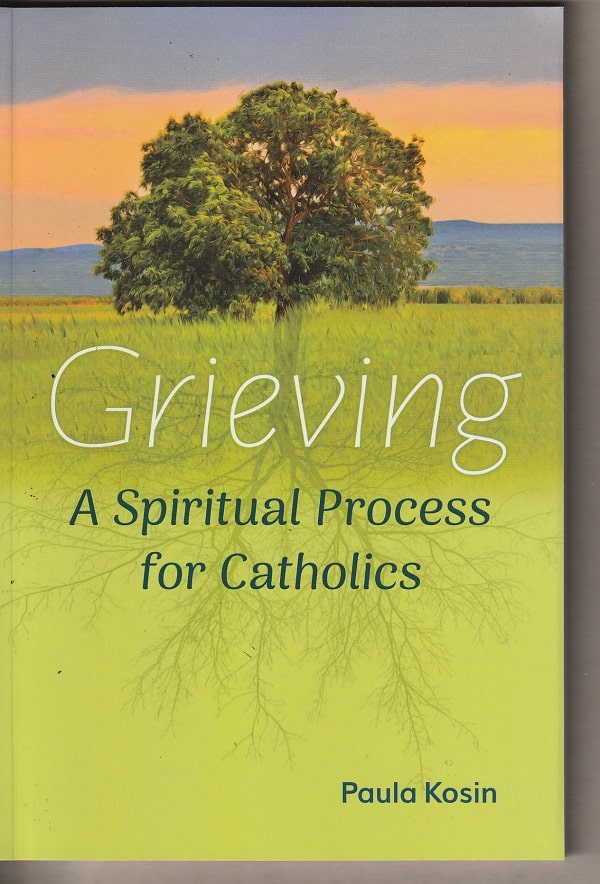If you are grieving or have grieved in the past, you know that people want to help, but, often, they just don’t know how.
In Grieving: A Spiritual Process for Catholics, Paula Kosin gives a fairly long list of things that people say that usually aren’t very helpful, such as:
- “It’s God’s will.”
- “God needed an angel.”
- “Haven’t you moved on?”
- “He’s in a better place.”
She also suggests some of the things that people can say to provide support and comfort — a simple “I’m sorry for your loss,” for example, or “If I can help in some way, I am here for you.” Perhaps her best advice is a phrase that she says could have served as a subtitle to the section on helping:
Stop Bringing Casseroles. Just Listen.
Kosin’s book (104 pages, $14.95), newly published by the Archdiocese of Chicago’s Liturgy Training Publications and available online at the LTP website and on amazon.com, is written for people who are coping with the loss of a loved one.
It is a sensible, measured and thoughtful companion for such mourners, looking at the process not only spiritually but also physically, psychologically and emotionally. It puts grief in context and presents various practices that can help heal, such as journaling and meditation as well as the sacraments.
Grieving: A Spiritual Process for Catholics could also serve as a strong resource to a grief support group, such as parishes are now starting to establish as part of a bereavement ministry.
For those grieving and those who want to help
Kosin, a grief support group facilitator, a member of a hospice vigil team and a certified grief educator, writes that her book is for “anyone who has experienced the loss of an adult loved one (a spouse, adult sibling, parent, adult child, other relative, coworker, or friend) and seeks guidance and inspiration as they mourn and heal from the loss.”

After reading this practical and inspiring book, I have the sense — and I don’t think Kosin would disagree — that this is a book that anyone could benefit from reading.
It would benefit those who want to help someone in deep grief but aren’t sure what to say or do. (Just remember: “Stop Bringing Casseroles. Just Listen.”) This includes people who live or work with the mourner. And, although the book is targeted to Catholics, I think anyone, regardless of religious affiliation or lack of belief, would find much of value here.
Everyone grieves differently
Death is very unsettling, especially in American society, focused as it is on a myth of everlasting youth. A person who is grieving has had a close encounter with death, and that can be disconcerting for friends and acquaintances.
For instance, Kosin makes the point that everyone grieves differently:
You may want to be more private in your grief, while a spouse, family member, or friend wants more closeness and sharing. To you, this may feel like clingy behavior that feels suffocating and intrusive for you.
On the other hand, you may be the one who wants to share and deepen intimacy, yet the other person pulls away, needing space to grieve.
Some people may be more demonstrative in their grief while others may not cry or show any physical expressions of loss. A person in grief might keep talking about the loved one for many months or years, and this can rattle others. It’s important, Kosin writes, to remember that grief is a very personal experience:
It is important for us not to judge others on whether they are grieving “correctly” or not, just as we don’t want to be judged on our way of mourning our loved one.
Two sentences
At this point in her text, Kosin provides a two-sentence reply that a mourn can use as a very practical way to respond to someone who seems to be critical of the mourner’s method of grieving:
“Everyone grieves in their own way and according to their own timing. It just isn’t for others to judge. Now, here is how I wish you could support me…”
Those are two rich sentences.
First, they recognize that the mourner is the only one who knows how his or her personal grief needs to be lived and expressed. Second, they remind the mourner and the other that there is no prescribed way of grieving. Third, they acknowledge that the mourner needs the help of others. And, fourth, they put forward a very specific, very personal way in which the mourner is asking to be helped.
Grieving: A Spiritual Process for Catholics is rich in this way of mixing the psychological and the practical, the internal and the external, the interpersonal and the spiritual.
The feelings of grief are taking place inside the mourner, but the mourner is constantly interacting with the rest of the world. Kosin’s book is a good road map through the difficult country of grief.
Patrick T. Reardon
4.27.23
Written by : Patrick T. Reardon
For more than three decades Patrick T. Reardon was an urban affairs writer, a feature writer, a columnist, and an editor for the Chicago Tribune. In 2000 he was one of a team of 50 staff members who won a Pulitzer Prize for explanatory reporting. Now a freelance writer and poet, he has contributed chapters to several books and is the author of Faith Stripped to Its Essence. His website is https://patricktreardon.com/.

Thank you, Patrick, for bringing your expertise as a lifelong award-winning journalist and book reviewer to reviewing my book.
Interested individuals and organizations can order it from Liturgy Training Publications ltp.org (bulk orders too) and from Amazon https://www.amazon.com/Grieving-Spiritual-Catholics-Paula-Kosin/dp/1616717238
Help this book find its way to those who need it most!